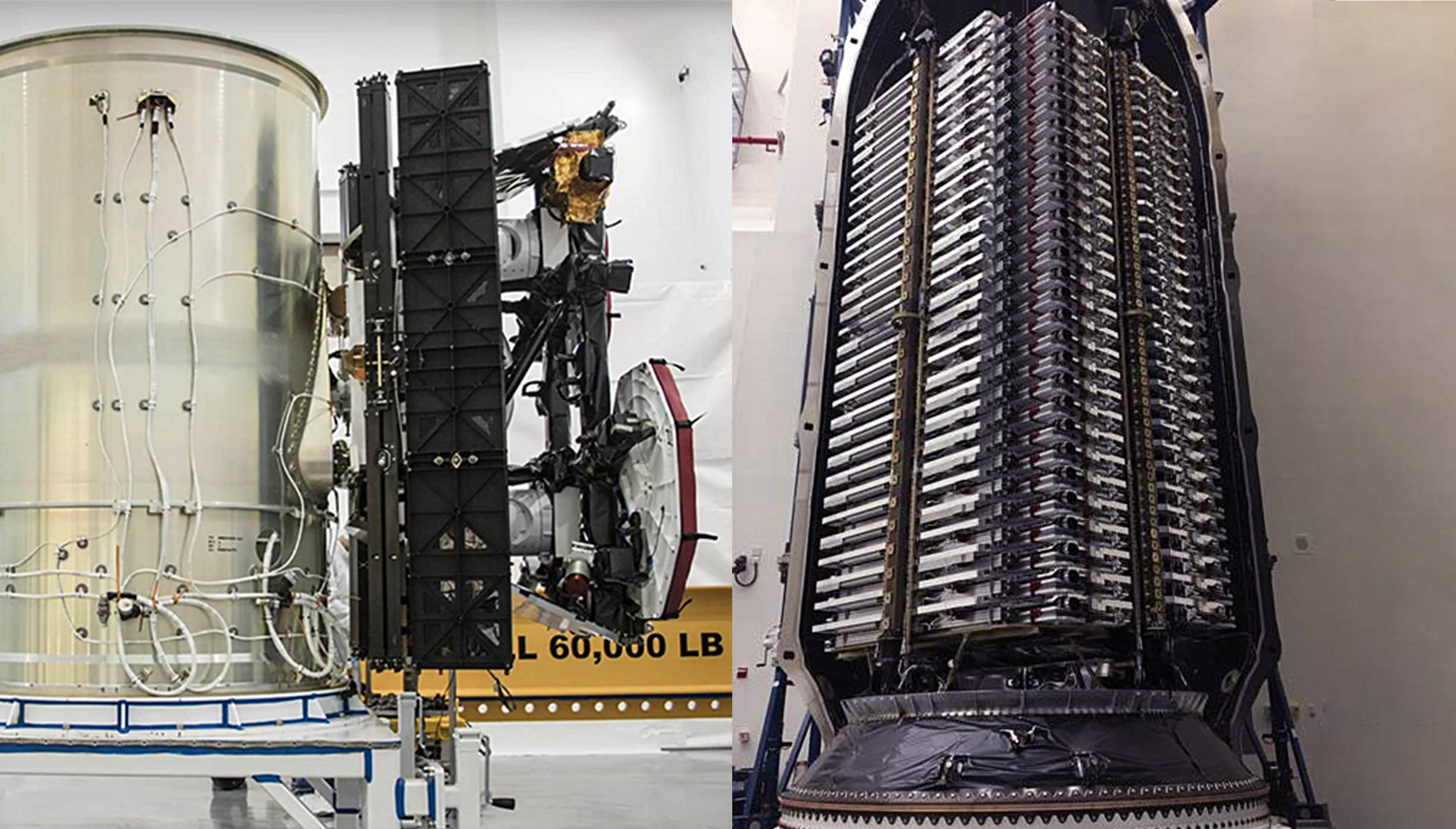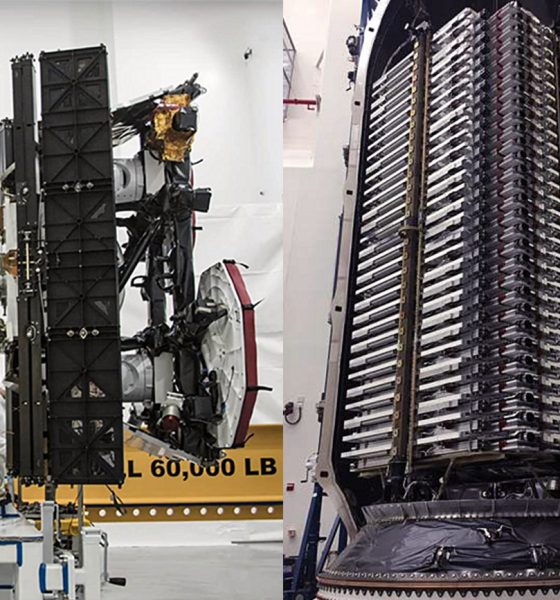

News
SpaceX CEO Elon Musk reveals radical Starlink redesign for 60-satellite launch
SpaceX CEO Elon Musk has published the first official photo of the company’s near-final Starlink design and confirmed that Falcon 9 will launch a staggering 60 satellites on May 15th.
Known internally as Starlink v0.9, this mission will not be the first launch of operational satellites, but it will be the first internal SpaceX mission with a dedicated Falcon 9 launch. Additionally, the payload will be the heaviest yet launched by SpaceX, signifying an extraordinarily ambitious first step towards realizing the company’s ~12,000-satellite Starlink megaconstellation.
Rewriting the satellite design book
Put simply, SpaceX’s Starlink v0.9 launch is extremely unique for several reasons. Aside from the unprecedented step of launching 60 spacecraft weighing ~13,000 kg (~30,000 lb) on a developmental mission, both the form factor of each satellite and the style of dispenser/payload adapter has never been seen before. SpaceX appears to have settled on a square dispenser with four separate quadrants for satellites. The satellites themselves look truly bizarre – it’s actually difficult to discern where one spacecraft stops and the next begins.
Nevertheless, it appears that each Starlink satellite is a relatively thin rectangle, possibly with a squared top and bottom. It’s also possible that they are all around rectangular and that the dispenser instead has two main sections. Either way, the very fact that the Starlink v0.9 payload can scarcely be parsed into recognizable satellites is thrilling. Aside from the rise of smallsats and cubesats, satellite design and engineering has been relatively stagnant for decades, particularly with respect to form factors and structural layouts. Most modern satellites are simply square-ish boxes with electronics inside and payloads bolted on the outside.

By all appearances, SpaceX’s Starlink beta satellites suffer from no such tried-and-true design tropes. This is a somewhat calculated risk, as those current tried-and-true satellite design rules are conservative but decidedly proven over dozens of years of orbital experience. To throw out the satellite design textbook is to invite an increased potential for failure in order to pursue entirely new ways of thinking, designing, building, and launching spacecraft.
Even relative to fairly innovative constellations like the SpaceX-launched Iridium NEXT and OneWeb look downright mundane when examined alongside SpaceX’s inaugural Borg-cube-esque payload. SpaceX’s Starlink layout looks like nothing seen before. At the same time, it appears that the bizarre, new approach has likely maximized the density and stacking efficiency of dozens of satellites to an unprecedented degree.
Despite using the same exact Falcon fairing that has been standard for years, SpaceX has managed to cram 60 spacecraft – each weighing around 200-300 kg – into just the bottom two-thirds of the fairing, leaving a considerable amount of unused volume for future expansion.
According to President and COO Gwynne Shotwell, Starlink v0.9 satellites are extremely close to SpaceX’s true final design. However, they are still considered by SpaceX to be a “test batch” of satellites and do not have the optical (laser) interlinks that will be a critical part of Starlink’s unique constellation design. The mission is currently scheduled to launch at 10:30 pm EDT (02:30 UTC), May 15th and will have a flexible four-hour window. The mission will be preceded by a routine Falcon 9 static fire no earlier than (NET) May 13th.
Update:
According to Musk, SpaceX has actually entirely gotten rid of a satellite-dispenser middle-man, instead relying on the structure of the satellites themselves to act as their own launch adapters and deployment mechanisms. This has been done in the past on a far smaller scale – typically with 2-3 several-ton satellites – but has never been attempted at the scale SpaceX is just days away from launching.
Check out Teslarati’s Marketplace! We offer Tesla accessories, including for the Tesla Cybertruck and Tesla Model 3.

News
Tesla starts showing how FSD will change lives in Europe
Local officials tested the system on narrow country roads and were impressed by FSD’s smooth, human-like driving, with some calling the service a game-changer for everyday life in areas that are far from urban centers.

Tesla has launched Europe’s first public shuttle service using Full Self-Driving (Supervised) in the rural Eifelkreis Bitburg-Prüm region of Germany, demonstrating how the technology can restore independence and mobility for people who struggle with limited transport options.
Local officials tested the system on narrow country roads and were impressed by FSD’s smooth, human-like driving, with some calling the service a game-changer for everyday life in areas that are far from urban centers.
Officials see real impact on rural residents
Arzfeld Mayor Johannes Kuhl and District Administrator Andreas Kruppert personally tested the Tesla shuttle service. This allowed them to see just how well FSD navigated winding lanes and rural roads confidently. Kruppert said, “Autonomous driving sounds like science fiction to many, but we simply see here that it works totally well in rural regions too.” Kuhl, for his part, also noted that FSD “feels like a very experienced driver.”
The pilot complements the area’s “Citizen Bus” program, which provides on-demand rides for elderly residents who can no longer drive themselves. Tesla Europe shared a video of a demonstration of the service, highlighting how FSD gives people their freedom back, even in places where public transport is not as prevalent.
What the Ministry for Economic Affairs and Transport says
Rhineland-Palatinate’s Minister Daniela Schmitt supported the project, praising the collaboration that made this “first of its kind in Europe” possible. As per the ministry, the rural rollout for the service shows FSD’s potential beyond major cities, and it delivers tangible benefits like grocery runs, doctor visits, and social connections for isolated residents.
“Reliable and flexible mobility is especially vital in rural areas. With the launch of a shuttle service using self-driving vehicles (FSD supervised) by Tesla in the Eifelkreis Bitburg-Prüm, an innovative pilot project is now getting underway that complements local community bus services. It is the first project of its kind in Europe.
“The result is a real gain for rural mobility: greater accessibility, more flexibility and tangible benefits for everyday life. A strong signal for innovation, cooperation and future-oriented mobility beyond urban centers,” the ministry wrote in a LinkedIn post.
News
Tesla China quietly posts Robotaxi-related job listing
Tesla China is currently seeking a Low Voltage Electrical Engineer to work on circuit board design for the company’s autonomous vehicles.

Tesla has posted a new job listing in Shanghai explicitly tied to its Robotaxi program, fueling speculation that the company is preparing to launch its dedicated autonomous ride-hailing service in China.
As noted in the listing, Tesla China is currently seeking a Low Voltage Electrical Engineer to work on circuit board design for the company’s autonomous vehicles.
Robotaxi-specific role
The listing, which was shared on social media platform X by industry watcher @tslaming, suggested that Tesla China is looking to fill the role urgently. The job listing itself specifically mentions that the person hired for the role will be working on the Low Voltage Hardware team, which would design the circuit boards that would serve as the nervous system of the Robotaxi.
Key tasks for the role, as indicated in the job listing, include collaboration with PCB layout, firmware, mechanical, program management, and validation teams, among other responsibilities. The role is based in Shanghai.
China Robotaxi launch
China represents a massive potential market for robotaxis, with its dense urban centers and supportive policies in select cities. Tesla has limited permission to roll out FSD in the country, though despite this, its vehicles have been hailed as among the best in the market when it comes to autonomous features. So far, at least, it appears that China supports Tesla’s FSD and Robotaxi rollout.
This was hinted at in November, when Tesla brought the Cybercab to the 8th China International Import Expo (CIIE) in Shanghai, marking the first time that the autonomous two-seater was brought to the Asia-Pacific region. The vehicle, despite not having a release date in China, received a significant amount of interest among the event’s attendees.
Elon Musk
Elon Musk and Tesla AI Director share insights after empty driver seat Robotaxi rides
The executives’ unoccupied tests hint at the rapid progress of Tesla’s unsupervised Robotaxi efforts.

Tesla CEO Elon Musk and AI Director Ashok Elluswamy celebrated Christmas Eve by sharing personal experiences with Robotaxi vehicles that had no safety monitor or occupant in the driver’s seat. Musk described the system’s “perfect driving” around Austin, while Elluswamy posted video from the back seat, calling it “an amazing experience.”
The executives’ unoccupied tests hint at the rapid progress of Tesla’s unsupervised Robotaxi efforts.
Elon and Ashok’s firsthand Robotaxi insights
Prior to Musk and the Tesla AI Director’s posts, sightings of unmanned Teslas navigating public roads were widely shared on social media. One such vehicle was spotted in Austin, Texas, which Elon Musk acknowleged by stating that “Testing is underway with no occupants in the car.”
Based on his Christmas Eve post, Musk seemed to have tested an unmanned Tesla himself. “A Tesla with no safety monitor in the car and me sitting in the passenger seat took me all around Austin on Sunday with perfect driving,” Musk wrote in his post.
Elluswamy responded with a 2-minute video showing himself in the rear of an unmanned Tesla. The video featured the vehicle’s empty front seats, as well as its smooth handling through real-world traffic. He captioned his video with the words, “It’s an amazing experience!”
Towards Unsupervised operations
During an xAI Hackathon earlier this month, Elon Musk mentioned that Tesla owed be removing Safety Monitors from its Robotaxis in Austin in just three weeks. “Unsupervised is pretty much solved at this point. So there will be Tesla Robotaxis operating in Austin with no one in them. Not even anyone in the passenger seat in about three weeks,” he said. Musk echoed similar estimates at the 2025 Annual Shareholder Meeting and the Q3 2025 earnings call.
Considering the insights that were posted Musk and Elluswamy, it does appear that Tesla is working hard towards operating its Robotaxis with no safety monitors. This is quite impressive considering that the service was launched just earlier this year.










